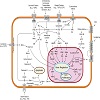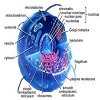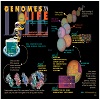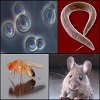| Scientific Approaches |

Biophysics
Biophysics is an interdisciplinary science that uses the methods of, and theories from physics to study biological systems. Researchers in our department use the tools of biophysics to address fundamental questions about the functioning of the human body. One example of how biophysical tools are used by our researchers is to study ion channels that regulate how the heart generates and maintains its regular beat, and how the heart controls its force of contraction. This research directly impacts our understanding and treatment of arrhythmia, atrial fibrillation and heart failure.
Researchers in our department who utilize biophysical tools in their research:
Accili, Kehl
|

Systems Biology
Systems biology is an emerging approach applied to biomedical and biological scientific research. Systems biology is a biology-based inter-disciplinary field of study that focuses on complex interactions within biological systems, using a more holistic approach to biological and biomedical research. Systems biology has revolutionized how modern researchers approach the study of disease. Systems biologists utilize tools from a diverse range of fields and expertise: quantitative biology, high resolution and quantitative imaging, structural biology, genomics, proteomics, mathematical modelling, materials science, network analysis, and many other disciplines.
Researchers in our department who are utilizing a systems biology approach:
Tanentzapf, Johnson, Underhill, Loewen, Haas, Kieffer, Nabi
|

Cell Biology
Cell biology is a scientific discipline that studies cells – their physiological properties, their structure, the organelles they contain, interactions with their environment, their life cycle, division and death. Researchers in our department who study cell biology study cells on both a microscopic and molecular level. Cell biological approaches provide detailed molecular insight into the mechanism that underlie complex disease processes.
Researchers in our department who work in the field of cell biology:
Underhill, Tanentzapf, Nabi, Loewen, Roskelley, Vogel, Johnson, Bamji, Moukhles, Naus, O’connor
|

Imaging
Researchers in our department utilize a diverse array of high resolution and quantitative imaging methods in both fixed and living tissues to gain insight into how cells and tissues function . This information can be used to understand the mechanisms that underlie various diseases and help in the design of promising therapies.
Researchers in our department who use imaging in their work:
Allan, Bamji, Tanentzapf, Vogl, Kieffer, Johnson, Haas, Moore, Underhill.
|

Genomics/Proteomics
Genomics is a discipline in genetics that applies recombinant DNA, DNA sequencing methods, and bioinformatics to sequence, assemble, and analyze the function and structure of genomes (the complete set of DNA within a single cell of an organism). Proteomics is the large-scale study of proteins, particularly their structures and functions. Researchers in our department utilize genomics and proteomics to gain basic insight into the functioning of biological systems and to try and uncover the mechanisms that underlie complex diseases. The knowledge gained from the use of genomics and proteomics can be translated into potential therapies for such diseases.
Researchers in our department who utilize genomics:
Clee, Allan, Johnson, Loewen, Nabi, Underhill
|

Model organisms
Researchers in our department use genetic model organisms to gain insight into the fundamental mechanisms of basic biological functions in the human body. Using genetic disease models this research can lead to increased understanding and the development of treatments for a range of diseases.
Some of the genetic model organisms that are used in our department:
Mouse:
Bamji, Johnson, Kieffer, Weinberg, Clee, Roskelley, Underhill
Yeast:
Loewen
Drosophila (fruit flies):
Tanentzapf, Allan, O’connor
Zebrafish:
Kieffer
|